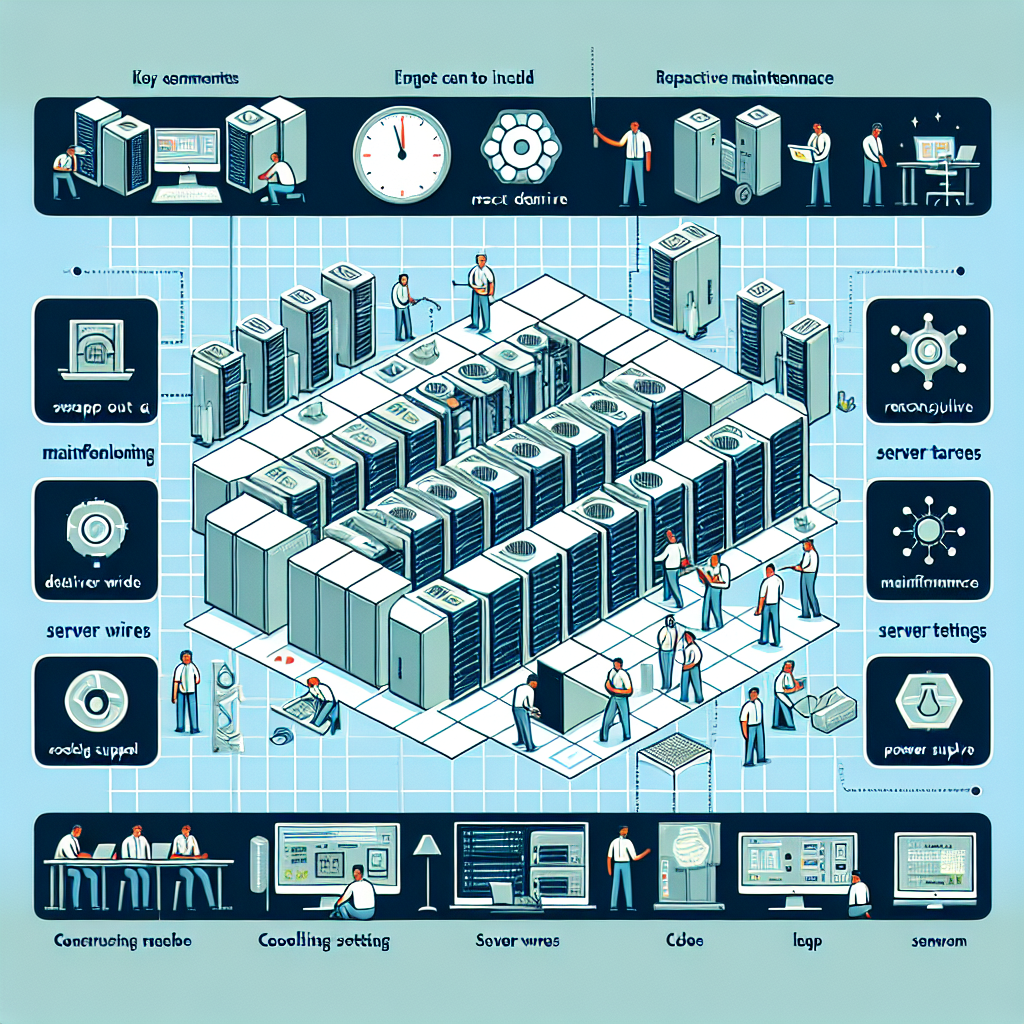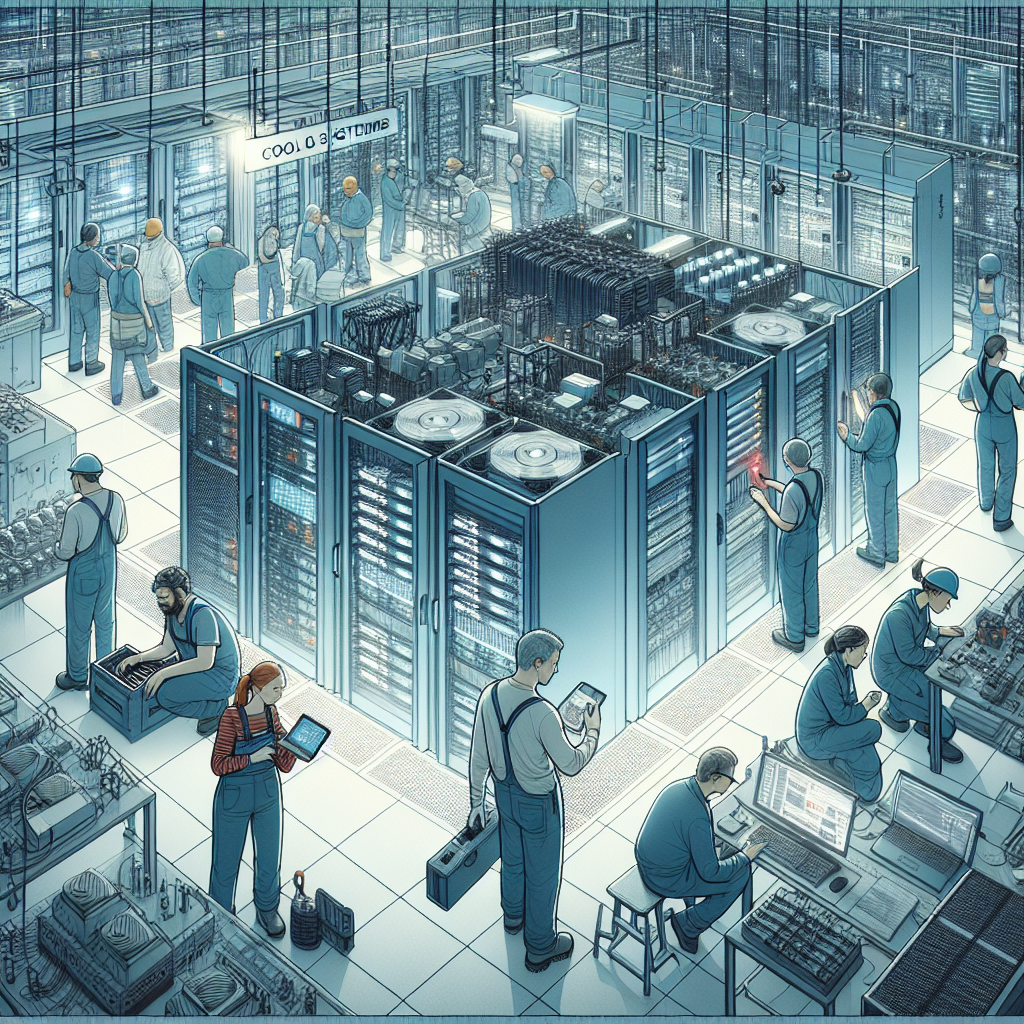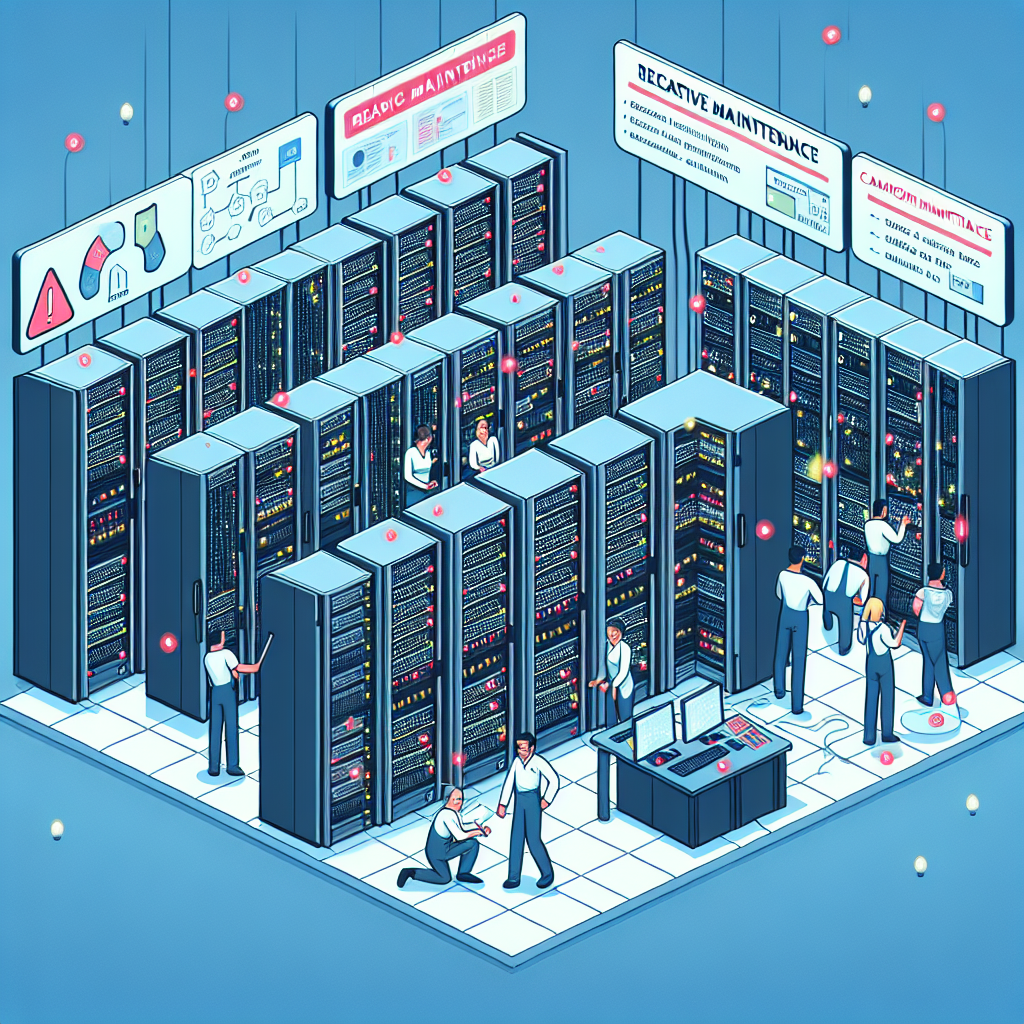Your cart is currently empty!
Tag: Data Center Reactive Maintenance

Best Practices for Implementing Data Center Reactive Maintenance
Data centers are the backbone of modern businesses, housing critical data and infrastructure that keep operations running smoothly. In order to ensure optimal performance and minimize downtime, proactive maintenance is essential. However, there are times when reactive maintenance is necessary to address unexpected issues that arise. Implementing data center reactive maintenance practices is crucial for maintaining the health and functionality of your data center. Here are some best practices to consider when implementing reactive maintenance in your data center:1. Establish a clear escalation process: In the event of a critical issue, it is important to have a clear escalation process in place. This ensures that the appropriate personnel are notified and can respond quickly to address the issue. Having a designated point of contact and clear communication channels will help streamline the response process and minimize downtime.
2. Conduct regular inspections and monitoring: Regular inspections and monitoring of critical systems and equipment can help identify potential issues before they escalate into major problems. Implementing a comprehensive monitoring system that tracks key performance metrics and alerts staff to any anomalies can help catch issues early and prevent downtime.
3. Prioritize critical systems: Not all systems and equipment are created equal when it comes to the impact on data center operations. It is important to prioritize critical systems and ensure that they receive the necessary attention during reactive maintenance activities. This may include creating a prioritized list of systems and equipment based on their importance to overall operations.
4. Develop a response plan: Having a well-defined response plan in place for reactive maintenance activities can help ensure a timely and effective response to issues. This plan should include detailed steps for diagnosing and resolving issues, as well as a timeline for completion. By having a response plan in place, staff can act quickly and efficiently when issues arise.
5. Document all maintenance activities: Keeping detailed records of all reactive maintenance activities is essential for tracking issues and identifying patterns of recurring problems. This documentation can also help identify areas for improvement and guide future maintenance efforts. By maintaining thorough records, data center staff can better understand the health of their systems and make informed decisions about maintenance strategies.
In conclusion, implementing best practices for data center reactive maintenance is essential for ensuring the continued health and functionality of your data center. By establishing clear escalation processes, conducting regular inspections and monitoring, prioritizing critical systems, developing a response plan, and documenting all maintenance activities, data center staff can effectively respond to issues as they arise and minimize downtime. By following these best practices, businesses can ensure that their data center remains reliable and operational, supporting their overall operations and success.

Maximizing Efficiency with Proactive Data Center Reactive Maintenance
Data centers are the heart of any organization’s digital infrastructure, housing critical hardware and software that keep businesses running smoothly. With the increasing reliance on technology, it is essential for data centers to operate at maximum efficiency to ensure uninterrupted service and minimize downtime.One way to maximize efficiency in data centers is through proactive data center reactive maintenance. This approach involves regularly monitoring and maintaining equipment to prevent potential issues before they occur, rather than waiting for a problem to arise and then fixing it reactively. By taking a proactive approach to maintenance, organizations can identify and address issues early on, reducing the risk of costly downtime and disruptions to operations.
Proactive data center reactive maintenance involves a combination of scheduled inspections, routine maintenance tasks, and continuous monitoring of equipment performance. By staying ahead of potential issues, organizations can extend the lifespan of their equipment, improve reliability, and reduce the likelihood of unexpected failures.
One key benefit of proactive maintenance is the ability to identify and address minor issues before they escalate into major problems. By regularly inspecting and maintaining equipment, organizations can catch issues early on and take corrective action to prevent downtime. This proactive approach can save organizations time and money in the long run by avoiding costly repairs and minimizing the impact of downtime on operations.
Another advantage of proactive maintenance is the ability to optimize equipment performance. By keeping equipment well-maintained and operating at peak efficiency, organizations can maximize the return on their investment and ensure that their data center is running at its full potential. This can lead to improved performance, reduced energy consumption, and increased productivity for the organization as a whole.
In conclusion, proactive data center reactive maintenance is a valuable strategy for maximizing efficiency in data centers. By taking a proactive approach to maintenance, organizations can prevent potential issues, improve equipment performance, and minimize downtime. With the increasing importance of technology in today’s business environment, it is essential for organizations to prioritize the maintenance of their data center infrastructure to ensure continued success and competitiveness in the digital age.

Navigating the Challenges of Data Center Reactive Maintenance
In today’s fast-paced digital world, data centers play a crucial role in storing and processing vast amounts of information. However, maintaining these facilities can be a daunting task, especially when unexpected issues arise. Reactive maintenance, which involves addressing problems as they occur, can be particularly challenging in a data center environment.One of the main challenges of data center reactive maintenance is the potential for downtime. Any disruption in the operation of a data center can have serious consequences, leading to data loss, decreased productivity, and ultimately, financial losses. Therefore, it is essential for data center managers to quickly identify and resolve any issues that may arise.
Another challenge of reactive maintenance is the lack of predictability. Since problems are only addressed after they occur, it can be difficult to anticipate when and where issues will arise. This can make it challenging for data center staff to plan and allocate resources effectively.
Furthermore, reactive maintenance can be more costly in the long run compared to proactive maintenance. By addressing issues before they escalate, data center managers can prevent costly downtime and repairs. However, in a reactive maintenance approach, expenses can quickly add up as problems continue to arise.
To navigate the challenges of data center reactive maintenance, it is crucial for data center managers to implement a proactive maintenance strategy. This involves regularly monitoring and maintaining critical infrastructure components to prevent issues from occurring in the first place.
Additionally, data center managers should invest in monitoring and diagnostic tools to detect potential issues before they escalate. By implementing predictive maintenance techniques, data center staff can identify and address problems before they impact operations.
Regularly training and educating data center staff on best practices for maintenance and troubleshooting can also help mitigate the challenges of reactive maintenance. By empowering staff with the knowledge and skills needed to address issues quickly and effectively, data center managers can minimize downtime and ensure the smooth operation of their facilities.
In conclusion, navigating the challenges of data center reactive maintenance requires a proactive approach to maintenance and monitoring. By investing in predictive maintenance techniques, training staff on best practices, and implementing monitoring tools, data center managers can effectively address issues before they impact operations. Ultimately, a proactive maintenance strategy can help data centers operate efficiently and effectively, minimizing downtime and maximizing productivity.

The Impact of Data Center Reactive Maintenance on Overall Operational Costs
In today’s fast-paced digital world, data centers play a crucial role in storing, processing, and managing vast amounts of data. With the increasing reliance on technology, businesses are constantly seeking ways to optimize their data center operations to ensure maximum efficiency and performance. One key factor that can significantly impact the overall operational costs of a data center is reactive maintenance.Reactive maintenance, also known as break-fix maintenance, refers to the practice of addressing equipment failures and issues as they occur, rather than proactively identifying and addressing potential problems before they escalate. While reactive maintenance may seem like a cost-effective approach in the short term, it can have a significant impact on the overall operational costs of a data center in the long run.
One of the main drawbacks of reactive maintenance is its unpredictability. Equipment failures can occur at any time, leading to unplanned downtime and disruptions in data center operations. This can result in lost productivity, revenue, and customer satisfaction. In addition, the cost of emergency repairs and replacement parts can quickly add up, leading to higher maintenance expenses.
Furthermore, reactive maintenance can also have a negative impact on the lifespan of data center equipment. By waiting until an issue arises to address it, the equipment is more likely to suffer from wear and tear, reducing its overall efficiency and performance. This can result in higher energy consumption and cooling costs, as well as increased risk of equipment failure.
On the other hand, proactive maintenance, also known as preventive maintenance, involves regularly scheduled inspections, maintenance, and repairs to identify and address potential issues before they escalate. By implementing a proactive maintenance strategy, data center operators can increase the reliability and performance of their equipment, reduce the risk of downtime, and extend the lifespan of their assets.
While proactive maintenance may require an initial investment in terms of time and resources, the long-term benefits far outweigh the costs. By reducing the frequency of emergency repairs and downtime, data center operators can lower their maintenance expenses and improve the overall operational efficiency of their facility. In addition, proactive maintenance can help to identify opportunities for optimization and efficiency improvements, leading to further cost savings.
In conclusion, the impact of data center reactive maintenance on overall operational costs cannot be underestimated. By shifting towards a proactive maintenance approach, data center operators can minimize the risk of equipment failures, reduce maintenance expenses, and improve the overall efficiency and performance of their facility. Investing in preventive maintenance is a strategic decision that can lead to long-term cost savings and operational excellence in the ever-evolving world of data centers.
Maximizing Efficiency and Performance Through Data Center Reactive Maintenance
In today’s fast-paced digital world, businesses rely heavily on data centers to store, manage, and process vast amounts of information. These data centers play a crucial role in ensuring the smooth operation of various systems and applications that are essential for the day-to-day operations of organizations.However, as data centers continue to grow in complexity and size, the need for efficient maintenance and upkeep becomes more critical. Reactive maintenance, also known as corrective maintenance, is a strategy that focuses on addressing issues as they arise rather than proactively preventing them. While proactive maintenance is ideal for preventing downtime and maximizing efficiency, reactive maintenance can still play a significant role in ensuring the smooth operation of data centers.
One of the key benefits of reactive maintenance is its ability to quickly address issues that may arise unexpectedly. By monitoring the performance of critical systems and components, data center managers can identify and address problems promptly, reducing the risk of downtime and minimizing the impact on operations. This can ultimately lead to improved efficiency and performance, as issues are resolved before they escalate into more significant problems.
However, it is essential to have a robust reactive maintenance plan in place to ensure that issues are addressed quickly and effectively. This includes having a team of skilled technicians available to respond to emergencies, as well as access to spare parts and equipment to facilitate repairs. Regular monitoring and testing of critical systems can also help identify potential issues before they become major problems, allowing for prompt intervention and resolution.
In addition to addressing unexpected issues, reactive maintenance can also play a role in identifying areas for improvement and optimization within data centers. By analyzing the root causes of problems and implementing corrective actions, data center managers can optimize performance and efficiency, ultimately leading to cost savings and improved reliability.
Overall, while proactive maintenance is essential for preventing downtime and maximizing efficiency in data centers, reactive maintenance can still play a valuable role in addressing unexpected issues and optimizing performance. By implementing a robust reactive maintenance plan and continuously monitoring critical systems, data center managers can ensure the smooth operation of their facilities and maximize efficiency and performance.

How to Minimize Downtime with Proactive Reactive Maintenance in Data Centers
In today’s fast-paced digital world, data centers play a crucial role in keeping our businesses running smoothly. With the increasing reliance on technology, minimizing downtime in data centers has become more important than ever. Downtime can be costly, not only in terms of lost revenue but also in damage to a company’s reputation and customer trust. To prevent these issues, data center operators need to implement proactive and reactive maintenance strategies to ensure maximum uptime.Proactive maintenance involves taking preventive measures to identify and address potential issues before they escalate into major problems. This includes regularly monitoring equipment and systems, performing routine maintenance tasks, and implementing best practices to extend the lifespan of hardware. By staying ahead of potential issues, data center operators can avoid unexpected downtime and reduce the risk of costly repairs.
One key aspect of proactive maintenance is regular equipment inspections. This involves checking for signs of wear and tear, monitoring performance metrics, and identifying any potential issues that may arise in the future. By conducting regular inspections, data center operators can catch problems early on and take corrective action before they lead to downtime.
In addition to proactive maintenance, data center operators also need to have a robust reactive maintenance plan in place. Reactive maintenance involves responding to issues as they occur, rather than proactively preventing them. While proactive maintenance is essential for minimizing downtime, reactive maintenance is equally important for quickly resolving issues and restoring service.
To effectively manage reactive maintenance, data center operators should have a clear escalation process in place. This includes identifying key contacts, establishing protocols for reporting and resolving issues, and maintaining a comprehensive inventory of spare parts and equipment. By having a well-defined reactive maintenance plan, data center operators can minimize downtime and ensure that issues are resolved quickly and efficiently.
Overall, a combination of proactive and reactive maintenance strategies is essential for minimizing downtime in data centers. By implementing regular equipment inspections, conducting routine maintenance tasks, and having a robust reactive maintenance plan in place, data center operators can ensure maximum uptime and avoid costly disruptions to their business operations. With the increasing reliance on technology, minimizing downtime in data centers is more important than ever. By implementing proactive and reactive maintenance strategies, data center operators can ensure that their systems are running smoothly and efficiently, ultimately leading to improved performance and customer satisfaction.

Common Challenges in Data Center Reactive Maintenance
Data centers are the backbone of modern technology, housing the servers and networking equipment that keep businesses running smoothly. However, even the most well-maintained data centers can encounter problems that require reactive maintenance to address. In this article, we will explore some of the common challenges that data center managers face when it comes to reactive maintenance.One of the biggest challenges in data center reactive maintenance is identifying the root cause of a problem. When an issue arises, it can be difficult to pinpoint exactly what is causing it, especially if it is a complex issue that affects multiple systems. This can lead to a delay in resolving the problem, as technicians may need to spend time troubleshooting before they can implement a fix.
Another challenge is the time constraints that data center managers face when dealing with reactive maintenance. When a critical system goes down, every minute of downtime can cost the business money. This puts pressure on technicians to quickly diagnose and resolve the issue, which can lead to mistakes or shortcuts being taken that may cause further problems down the line.
Data center managers also face challenges when it comes to coordinating maintenance activities with other teams and departments. In a large organization, there may be multiple teams responsible for different aspects of the data center infrastructure, such as networking, storage, and security. Coordinating efforts between these teams can be a complex task, especially when time is of the essence.
Additionally, data center managers must contend with the challenge of managing costs when it comes to reactive maintenance. Emergency repairs and replacements can be expensive, and data center managers must balance the need to keep systems running with the need to stay within budget constraints. This can be particularly challenging in organizations with limited resources or tight budgets.
Finally, data center managers must also consider the impact that reactive maintenance can have on the overall reliability and performance of the data center. Frequent reactive maintenance can indicate underlying issues with the infrastructure that may need to be addressed proactively to prevent future problems. Failure to address these issues can lead to a cycle of constant firefighting that can impact the stability of the data center.
In conclusion, data center reactive maintenance presents a number of challenges for data center managers, from identifying root causes and coordinating activities to managing costs and maintaining overall reliability. By understanding these challenges and taking a proactive approach to maintenance, data center managers can minimize downtime, reduce costs, and ensure the continued smooth operation of their data centers.

Future Trends in Data Center Reactive Maintenance: What to Expect
As technology continues to advance at a rapid pace, data centers are becoming increasingly complex and crucial for businesses to operate efficiently. With the rise of big data, cloud computing, and the Internet of Things (IoT), the demand for data center services is only expected to grow in the coming years. As a result, data center reactive maintenance is becoming more important than ever before.Reactive maintenance refers to the practice of fixing issues in a data center after they have occurred, rather than proactively preventing them. While proactive maintenance is still important for preventing downtime and ensuring optimal performance, reactive maintenance is necessary for addressing unexpected issues that can arise at any time.
So, what can we expect in terms of future trends in data center reactive maintenance? Here are a few key developments to keep an eye on:
1. Increased Automation: With the rise of artificial intelligence (AI) and machine learning, data centers are becoming more automated than ever before. This includes the use of predictive analytics to anticipate potential issues before they occur, as well as automated troubleshooting and repair processes. As a result, data center reactive maintenance is becoming more efficient and effective.
2. Remote Monitoring and Management: As data centers become more complex and distributed, remote monitoring and management tools are becoming essential for ensuring optimal performance. These tools allow data center operators to monitor and manage their infrastructure from anywhere in the world, enabling them to quickly respond to issues as they arise.
3. Predictive Maintenance: In addition to proactive and reactive maintenance, predictive maintenance is becoming increasingly important for data centers. This involves using data analytics and machine learning algorithms to predict when equipment is likely to fail, allowing operators to schedule maintenance before issues occur. This can help to prevent downtime and reduce maintenance costs in the long run.
4. Energy Efficiency: As data centers consume a significant amount of energy, there is a growing focus on improving energy efficiency in data center operations. This includes the use of advanced cooling systems, energy-efficient hardware, and renewable energy sources. By reducing energy consumption, data centers can lower their operating costs and minimize their environmental impact.
5. Cybersecurity: With the increasing threat of cyber attacks, data center operators are placing a greater emphasis on cybersecurity measures to protect their infrastructure and data. This includes implementing robust security protocols, conducting regular security audits, and training staff on best practices for preventing cyber attacks. In the future, data center reactive maintenance will need to address cybersecurity issues in addition to traditional hardware and software issues.
In conclusion, the future of data center reactive maintenance is likely to be characterized by increased automation, remote monitoring and management, predictive maintenance, energy efficiency, and cybersecurity. By staying ahead of these trends and adopting the latest technologies and best practices, data center operators can ensure that their infrastructure remains reliable, secure, and efficient in the years to come.

Improving Efficiency and Performance Through Data Center Reactive Maintenance
In today’s fast-paced business environment, companies rely heavily on their data centers to store and process critical information. Any downtime or performance issues can have a significant impact on operations, leading to lost revenue and potential damage to a company’s reputation. To ensure optimal performance and efficiency, data center managers need to implement a proactive maintenance strategy that includes reactive maintenance.Reactive maintenance involves addressing issues as they arise, rather than waiting for scheduled maintenance intervals. This approach allows data center managers to quickly identify and resolve problems before they escalate and cause downtime. By staying on top of potential issues, companies can minimize the impact of unexpected outages and keep their operations running smoothly.
There are several key benefits to implementing a data center reactive maintenance strategy. First and foremost, it helps improve efficiency by reducing downtime and maximizing uptime. When issues are addressed promptly, data center operations can continue without interruption, ensuring that critical business processes are not disrupted.
Reactive maintenance also helps extend the lifespan of data center equipment. By addressing issues early on, companies can prevent minor problems from turning into major issues that require costly repairs or replacements. This can ultimately save companies money in the long run by reducing the need for expensive equipment upgrades.
Furthermore, a proactive reactive maintenance strategy can help improve overall performance. By regularly monitoring and addressing issues, data center managers can identify trends and patterns that may be impacting performance. By addressing these issues promptly, companies can optimize their data center infrastructure and ensure that it is operating at peak efficiency.
To effectively implement a data center reactive maintenance strategy, companies should invest in monitoring tools and technologies that can help identify and track potential issues. These tools can provide real-time data on the performance of data center equipment, allowing managers to quickly identify and address any issues that arise.
In addition, companies should establish clear protocols and procedures for addressing maintenance issues. This includes creating a system for logging and tracking maintenance requests, assigning tasks to appropriate personnel, and communicating effectively with all stakeholders involved in the maintenance process.
By implementing a proactive reactive maintenance strategy, companies can improve efficiency and performance in their data centers. By staying on top of potential issues and addressing them promptly, companies can minimize downtime, extend the lifespan of equipment, and optimize overall performance. Ultimately, investing in reactive maintenance can help companies maximize the value of their data center infrastructure and ensure that their operations run smoothly and efficiently.

Case Studies: Successful Implementation of Data Center Reactive Maintenance
Data centers are the backbone of modern businesses, housing critical IT infrastructure and data that keep operations running smoothly. With the increasing reliance on technology, ensuring that data centers are well-maintained and functioning optimally is essential. Reactive maintenance, which involves responding to issues as they arise, is a key aspect of keeping data centers up and running.In this article, we will explore some case studies of successful implementation of data center reactive maintenance, highlighting the importance of quick and effective problem-solving in maintaining the reliability and efficiency of data centers.
Case Study 1: Company A
Company A is a leading technology company that operates several data centers across the country. They faced a major issue when one of their data centers experienced a power outage due to a faulty UPS system. The outage resulted in a disruption of services for their clients, causing significant financial losses.
In response to the outage, Company A’s maintenance team quickly sprang into action, identifying the root cause of the issue and implementing a solution to resolve it. They worked diligently to repair the UPS system and restore power to the data center, minimizing downtime and ensuring that services were back up and running within a few hours.
The quick and effective response of Company A’s maintenance team showcased the importance of proactive monitoring and reactive maintenance in ensuring the reliability of data center operations. By promptly addressing issues as they arise, Company A was able to minimize the impact of the outage and maintain the trust of their clients.
Case Study 2: Company B
Company B is a global financial services firm that operates multiple data centers to support its operations. They faced a critical issue when one of their data centers experienced a cooling system failure, leading to an increase in temperature within the facility.
Recognizing the importance of maintaining optimal operating conditions within their data centers, Company B’s maintenance team immediately responded to the cooling system failure. They quickly identified the issue, sourced the necessary replacement parts, and worked tirelessly to repair the system and restore proper cooling to the data center.
Thanks to the swift and efficient response of Company B’s maintenance team, they were able to prevent any damage to the IT equipment and avoid any disruptions to their operations. The proactive approach to reactive maintenance demonstrated by Company B’s team underscored the importance of continuous monitoring and quick problem-solving in maintaining the reliability of data center infrastructure.
In conclusion, these case studies highlight the critical role of reactive maintenance in ensuring the smooth operation of data centers. By promptly addressing issues as they arise and implementing effective solutions, companies can minimize downtime, prevent disruptions, and maintain the reliability of their data center operations. Proactive monitoring and a proactive approach to maintenance are key to success in the fast-paced world of data center management.
